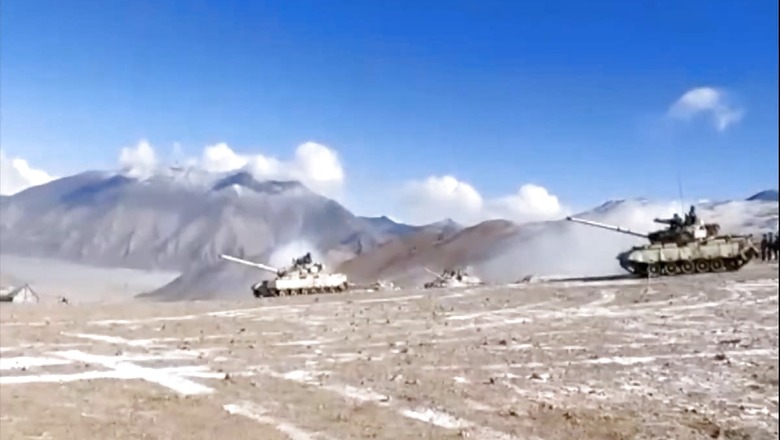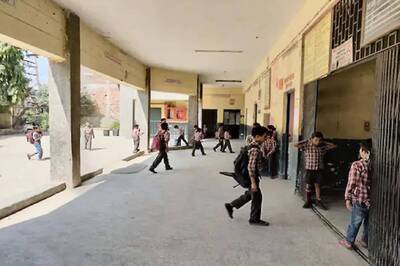
views
Top government on Thursday told CNN-News18 that the first phase of disengagement, currently underway in Pangong Tso in Ladakh, will be complete in 15-20 days. The strategic heights India has occupied in the south bank will be the last to be vacated in this phase, they added.
?There is an agreement. A mutual verification will happen at every step. The Kailash range will see disengagement once we are satisfied with the way things progress in other parts of Pangong Tso,? a senior officer told CNN-News18.
The disengagement of tanks and armoured vehicles in south bank was completed by Thursday evening; there were more than 100 tanks on both sides.
The 10th Corps Commander meeting will be held 48 hours after disengagement in Pangong Tso is complete. This is when other friction points like Depsang and Gogra Hotsprings and Demchok will be discussed, sources said.
The LAC disengagement?Pullback of PLA at Pangong Tso. #IndiaChinaStandOff@shreyadhoundial shares details with @maryashakil. pic.twitter.com/QRGIci20PN? News18 (@CNNnews18) February 11, 2021
?This is a positive step. The Chinese have agreed to go back to Finger 8 in the North Bank. From here on, we expect the process to play out as planned. The Chinese rapidly led out their tanks from the south bank yesterday. But let?s see how things play out,? said the top source.
A video released by the Army shows Indian and Chinese tanks withdrawing in South Bank. What it also highlights is how close the big guns were to each other.
Defence Minister Rajnath Singh on Thursday said an agreement has been reached with China on disengagement of frontline troops deployed at the North and South Bank of Pangong Lake after a nearly 10-month long standoff.
The disengagement at Pangong Lake, one of the key friction points on the contested Line of Actual Control (LAC), will be the first step in the long process of de-escalation.
Under the India-China agreement on the disengagement process, the Chinese army will pull back its troops to the east of Finger 8 areas in the northern bank of Pangong lake. Indian troops will be based at their permanent location at Dhan Singh Thapa post near Finger 3 areas.
Singh?s statement clearly implied that the areas between the Indian position in Finger 3 and Finger 8 will effectively become a no patrolling zone till a resolution on future deployment is reached, defence experts said. The Chinese military built several bunkers and other structures in the areas between Finger 4 and 8 and had blocked all Indian patrols beyond Finger 4, triggering strong reaction from the Indian Army. In the nine rounds of military talks, India was specifically insisting on withdrawal of Chinese troops from Finger 4 to Finger 8 on the North bank of Pangong Lake. The mountain spurs in the area are referred to as Fingers. Dr Laxman Behera, associate professor at the National Security Centre in Jawaharlal Nehru University described as significant the announcement that Chinese army will pull back troops to Finger 8 areas.
?It is a significant development. I think it will be a major step in taking forward the overall disengagement process though it came very late,? Behera told PTI. In his address in Rajya Sabha, the defence minister said similar action would be taken in the South Bank of the Pangong lake areas by both sides. Around five months ago, Indian troops occupied a number of strategic heights in the Mukhpari, Rechin La and Magar hill areas around the southern bank of the Pangong lake after the Chinese military attempted to intimidate them in the area. ?A similar action would be taken in the South bank area by both sides. These are mutual and reciprocal steps and any structures that had been built by both sides since April 2020 in both North and South bank areas will be removed and the landforms will be restored,? the defence minister said.
He said it was also agreed to have a temporary moratorium on military activities by both sides in the North bank of Pangong lake including patrolling to the traditional areas. ?Patrolling will be resumed only when both sides reach an agreement in diplomatic and military talks that would be held subsequently.The implementation of this agreement started yesterday in the North and South Bank of the Pangong Lake,? he said. Singh said it was also agreed to hold the next meeting of Senior Commanders of the two armies within 48 hours after complete disengagement in Pangong lake areas to resolve any remaining issues.
In addition, the Chinese side had mobilised a large number of troops and armaments along the LAC as well as in the depth areas. Our armed forces too had made adequate and effective counter deployments in these areas to ensure that India?s security interests were fully protected. In his address, Singh also presented a genesis of the standoff and said the Chinese side had mobilised a large number of troops and armaments along the LAC as well as in the depth areas, adding Indian armed forces too had made adequate and effective counter deployments to ensure that India?s security interests were fully protected ?I am proud to say that our armed forces have responded to the challenges posed by the unilateral Chinese action and have shown valour and courage on both South and North bank of Pangong Tso,? he said.
?Many strategically important points were identified and our troops positioned themselves at those hilltops and at locations which were very important from our point of view. It is because of this great bravery of our Armed Forces in the face of harsh adverse climatic conditions that we maintained the edge,? Singh said. He said the Armed Forces proved yet again that territorial integrity of India remains safe in their hands and their grit and determination to safeguard our borders is unwavering.
The defence minister said three key principles determined India?s approach in handling the situation which is ?both sides should strictly respect and observe the LAC, neither side should attempt to alter the status quo unilaterally, and all agreements and understandings between the two sides must be fully abided by in their entirety.? He also gave a historical account of the border issue between the two countries. ?As the House is aware, China illegally occupied approximately 38,000 sq km in the Union Territory of Ladakh, mainly during the 1962 conflict. In addition, under the so-called Sino-Pakistan ?boundary agreement? of 1963, Pakistan illegally ceded 5,180 sq km of Indian territory in Pakistan Occupied Kashmir to China,? he said. ?China thus is in illegal occupation of more than 43,000 sq km of Indian territory. It also claims approximately 90,000 sq km of Indian territory in the eastern sector of the India-China boundary in Arunachal Pradesh,? he added. Singh asserted that India has never accepted this ?illegal occupation? of our territory or the ?unjustified claims?.
He also mentioned India?s consistent stand that while bilateral ties can develop in parallel with discussions on resolving the boundary issue, any serious disturbance in peace and tranquillity along the LAC is bound to have ?adverse implications? for the direction of the overall relationship. ?The Chinese side is well aware of our position. In fact, various high-level joint statements have acknowledged this point that maintenance of peace and tranquillity along the LAC in the border areas is a fundamental premise for the development of relations,? the defence minister said.
Read all the Latest News, Breaking News and Coronavirus News here




















Comments
0 comment